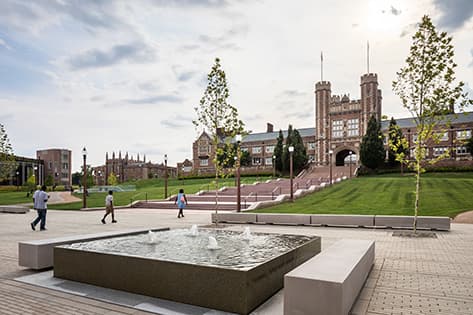Brain decoder controls spinal cord stimulation
Ismael Seáñez’s lab develops brain wave decoder that may help in spinal cord injury rehabilitation

When a person sustains an injury to the spinal cord, the normal communication between the brain and the spinal circuits below the injury are interrupted, resulting in paralysis. Because the brain is functioning normally, as is the spinal cord below the injury, researchers have been working to re-establish the communication to allow for rehabilitation and potentially restore movement.
Ismael Seáñez, assistant professor of biomedical engineering in the McKelvey School of Engineering at Washington University in St. Louis and of neurosurgery at WashU Medicine, and members of his lab, including Carolyn Atkinson, a doctoral student, have developed a type of decoder to restore that communication. Through experiments in their lab with 17 human subjects without a spinal cord injury, they were able to cue movement in the lower leg with transcutaneous spinal cord stimulation, or noninvasive, external electrical pulses.
Results of the research were published online April 25, 2025, in the Journal of NeuroEngineering and Rehabilitation.
The team used a special cap fitted with noninvasive electrodes that measure brain activity through electroencephalography (EEG). While wearing the cap, seated volunteers were asked to extend their leg at the knee, then to only think about extending their leg – while keeping it still — so researchers could record the brain waves in both exercises.
The team provided the neural activity to the decoder, or algorithm, so it could learn how the brain waves act in both circumstances. They found that the actual movement and imagined movement used similar neural strategies.
“After we give the decoder this data, it learns to predict based on neural activity whenever there is movement or no movement,” Seáñez said. “We show that we can predict whenever someone is thinking about moving their leg, even if their leg does not actually move.”
The team used controls to ensure that the volunteers were truly imagining movement and not actually moving.
“Whenever people move, this can introduce signal noise, and we want to make sure that the signal noise is not what we're learning to predict,” Seáñez said. “It's movement intention or brain activity that we want to predict, so we have people imagine that they're extending their leg and use the same algorithm that has been trained on people moving to predict whether they were imagining or not.”
Seanez said this reveals two things.
“One, that it's more likely that we're decoding movement intention and not an artifact, or noise, and second, whenever we employ this on people with spinal cord injury who will not have that ability to actually move their legs for us to label the data, we could use their imagination of moving a leg to train our decoder.”
Seáñez said the proof-of-concept study is a first step toward developing a noninvasive brain-spine interface that uses real-time predictions to deliver transcutaneous spinal cord stimulation to reinforce voluntary movement in a single joint in rehabilitation in patients with a spinal cord injury.
Going forward, the team plans to test a generalized decoder trained on data from all participants that could determine whether a universal decoder could perform as well as a personalized one and simplify its use in clinical settings.
Atkinson C, Lombardi L, Lang M, Keesey R, Hawthorn R, Seitz Z, Leuthardt EC, Brunner P, Seáñez I. Development and evaluation of a non-invasive brain-spine interface using transcutaneous spinal cord stimulation. Journal of NeuroEngineering and Rehabilitation, online April 25, 2025. DOI: https://doi.org/10.1186/s12984-025-01628-6.
Funding for this research was provided by the McDonnell Center for Systems Neuroscience at Washington University in St. Louis; the National Institutes of Health (K12-HD073945, K01-NS127936; R01-EB026439; P41-EB018783); the Department of Biomedical Engineering in McKelvey Engineering at WashU; and the Department of Neurosurgery at WashU Medicine.





